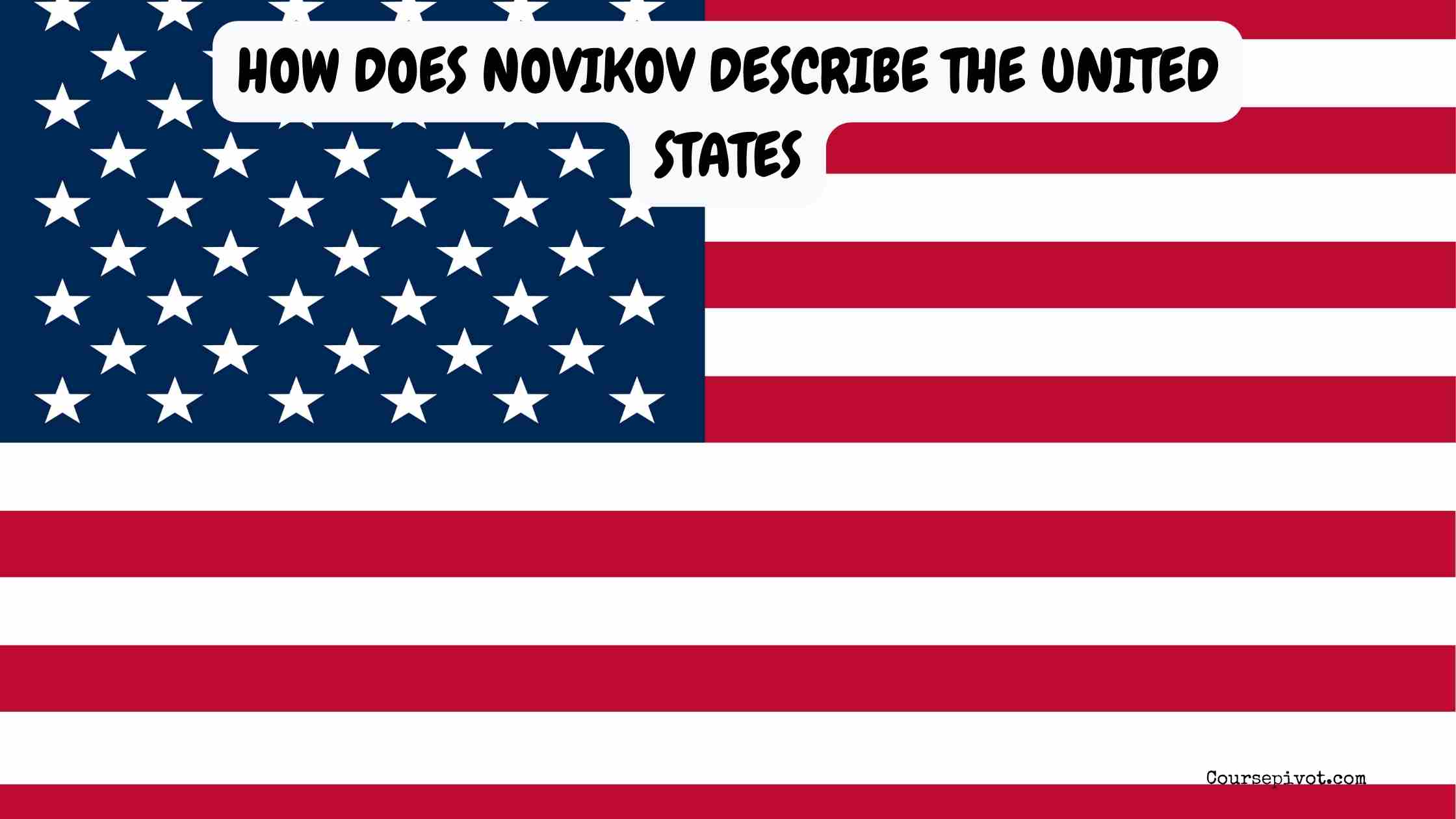
How Does Novikov Describe the United States?
Nikolai Novikov, a Soviet diplomat, offered a critical perspective on the United States during the early Cold War, a time of intense ideological rivalry. As someone who’s studied historical documents like Novikov’s, I find his views both revealing and shaped by his Soviet lens. His description of the United States, primarily in his 1946 “Long Telegram,” paints a picture of a nation with ambitious, often aggressive intentions. But how exactly does he describe the United States? What evidence does he use to support his claims? This article dives into Novikov’s portrayal, exploring his perspective with clarity and depth while addressing the biases that color his words.
Table of Contents
Understanding Novikov’s description is key to grasping the Cold War’s origins. His telegram, sent to Soviet leadership, reflects the suspicion and tension of the era. Why does his view matter? It shaped Soviet policy and fueled global rivalry. Let’s explore Novikov’s depiction of the United States and the evidence he cites, offering a balanced look at his claims.
What drives such a critical portrayal? Novikov’s role as a Soviet ambassador meant he saw the United States through the lens of competition. His words reveal not just his observations but the fears of a nation bracing for conflict. Here’s how he describes the United States and why it matters.
Novikov’s Description of the United States
In his September 1946 telegram, Nikolai Novikov describes the United States as an imperialist power striving for world supremacy. He portrays the U.S. as a nation driven by monopolistic capitalism, with a foreign policy aimed at dominating global politics, economics, and military affairs. To Novikov, the United States isn’t just a rival—it’s a threat to the Soviet Union and global stability. His tone is wary, reflecting the ideological clash between capitalism and communism.
Why such a harsh view? As a Soviet diplomat, Novikov saw U.S. actions as aggressive moves to contain communism and expand American influence. His description frames the U.S. as a calculating power, eager to reshape the world in its image.
- Read our blog on 7 Signs Your Child Doesn’t Respect You
Evidence Novikov Uses to Support His Description
Novikov doesn’t just make claims—he backs them with evidence, though his interpretations are heavily influenced by Soviet ideology. Here’s how he supports his portrayal:
U.S. Foreign Policy and the Monroe Doctrine
Novikov points to the Monroe Doctrine as evidence of American imperialism. He argues it shows the U.S.’s intent to dominate the Western Hemisphere, excluding European powers.
“The Monroe Doctrine, which proclaims the exclusive right of the United States to dominate the American continent, was the first manifestation of American imperialism.”
He sees this as a historical precedent for the U.S.’s global ambitions, suggesting a pattern of territorial and political control.
Military Expansion and Bases
Novikov highlights the U.S.’s military buildup, particularly its network of naval and air bases. He notes plans for 228 bases in the Atlantic and 258 in the Pacific, many outside U.S. territory. This, he claims, shows a desire for global military dominance.
“Broad plans for expansion have been developed, to be realized both diplomatically and through the creation of a system of naval and air bases far from the US.”
To Novikov, these bases are proof of an aggressive strategy to encircle rivals like the Soviet Union.
Economic Policies and Capitalism
Novikov describes the U.S. as driven by monopolistic capital, with economic policies serving a small group of capitalists. He cites the U.S.’s post-war economic dominance, including its leadership in manufacturing and trade agreements, as evidence of its intent to control global markets. This economic power, he argues, supports the U.S.’s imperialist goals, allowing it to influence weaker nations.
Strategic Timing in World War II
Novikov claims the United States planned to enter World War II at the last moment to maximize its influence while minimizing losses.
“It was thought that the main competitors of the United States would be crushed or greatly weakened in the war, and the United States… would assume the role of the most powerful factor in resolving the fundamental questions of the postwar world.”
He sees this as a calculated move to ensure U.S. dominance, with weakened rivals like Germany and Japan leaving a power vacuum for the U.S. to fill.
Arms Race and Military Spending
Novikov points to the U.S.’s military budget as evidence of its aggressive intentions. He notes that the 1946-1947 budget allocated $13 billion for the Army and Navy, a tenfold increase from 1938’s $1 billion. This arms race, including the development of new weapons, signals to Novikov a push for global supremacy.
Contextualizing Novikov’s Perspective
Novikov’s description is rooted in the Cold War’s ideological divide. As a Soviet diplomat, his views reflect the USSR’s fear of U.S. dominance and its own desire to counter capitalism. His evidence—while factual in areas like military spending or base construction—is interpreted through a lens of suspicion. For example, the Monroe Doctrine, a 19th-century policy, is framed as a stepping stone to modern imperialism, which may exaggerate its relevance.
Why does this matter? Novikov’s telegram mirrors the U.S.’s own “Long Telegram” by George Kennan, which described the Soviet Union as expansionist. Both documents fueled mutual distrust, escalating the Cold War. Novikov’s portrayal isn’t just an observation—it’s a call to Soviet leadership to resist U.S. influence.
Contrasting Views and Bias
Not all sources agree with Novikov’s depiction. Some describe him as viewing the U.S. as a land of opportunity, emphasizing its reputation for freedom and economic mobility. This positive portrayal, however, seems inconsistent with his 1946 telegram, which is overwhelmingly critical. The discrepancy likely stems from misinterpretations or incomplete sources, as Novikov’s role as a Soviet ambassador aligns with a critical stance. His bias, shaped by Soviet ideology, leads him to frame U.S. actions as inherently aggressive, ignoring potential defensive motives.
Have you ever wondered how bias shapes historical narratives? Novikov’s description shows how perspective can color facts, turning military bases into proof of imperialism rather than strategic defense.
Impact of Novikov’s Description
Novikov’s portrayal influenced Soviet policy, reinforcing the need to counter U.S. influence. His telegram justified Soviet actions, like expanding their own military or forming alliances, as responses to U.S. aggression. This mutual suspicion—U.S. fear of communism, Soviet fear of capitalism—drove the Cold War’s escalation.
What’s the lesson here? Perceptions, even if biased, shape global events. Novikov’s description, while critical, reflects the fears of a nation navigating a new world order.
Final Thoughts
Nikolai Novikov describes the United States as an imperialist power seeking world supremacy, driven by monopolistic capitalism and aggressive foreign policy. He supports this with evidence like the Monroe Doctrine, military expansion, economic dominance, strategic World War II timing, and massive military spending. His perspective, shaped by Cold War tensions and Soviet ideology, portrays the U.S. as a threat to global stability. In my view, Novikov’s description, while grounded in some facts, is colored by bias, framing U.S. actions as purely aggressive.
Why does this matter today? Understanding Novikov’s view helps us see how competing narratives fuel conflict. His telegram reminds us that history is shaped by perspective as much as by facts. What’s your takeaway? For me, it’s the power of perception in driving global rivalries—and the need to question biased narratives to find the truth.
Cite this article
You can copy and paste your preferred citation format below.
Martin, L. & Arquette, E.. (2025, May 28). How Does Novikov Describe the United States?. Coursepivot.com. https://coursepivot.com/blog/how-does-novikov-describe-the-united-states/



